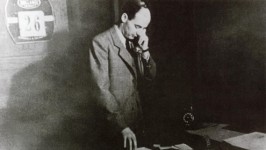“One man can make a difference.”
No one is so strong – for good or evil as a man with a goal and a conviction.
This is written in the aftermath of the monstrous terrorist murder in Norway. These murders, committed through evil conviction, ended or changed the lives of hundreds of people.
“One man can make a difference.” That is the sentence written over the front door of the Raoul Wallenberg School in Brooklyn, New York – one of many schools honouring Raoul Wallenberg, a man who showed that good conviction could save thousands of lives.
Raoul Wallenberg was the young Swede sent to Budapest in the end of WW2 in order to use passports from neutral Sweden to protect Jews threatened with immediate deportation to the death camps.
He was a young man from a wealthy family, ready to risk his life for human beings he had never met and had no relation to. He and his collaborators saved tens of thousands of Jews. That has made Raoul Wallenberg – who on the 4th of August 2012 would have been one hundred years old – a symbol of unselfishness and courage.
Gideon Hausner was the Israeli Attorney General between 1960 and 1963. He headed the prosecution at the war crimes trial of Adolf Eichmann in Jerusalem fifty years ago and later served as the president of Yad Vashem, the foremost museum and monument of the Holocaust. He wrote of Raoul Wallenberg:
“Here is a man who had the choice of remaining in secure, neutral Sweden when Nazism was ruling Europe. Instead, he left this haven and went to what was then one of the most perilous places in Europe – Hungary. And for what? To save Jews. He won his battle and I feel that in this age when there is so little to believe in – so very little on which our young people can pin their hopes and ideals – he is a person to show to the world, which knows so little about him. That is why I believe the story of Raoul Wallenberg should be told and his figure, in all its true proportions, projected into human minds.”
Raoul Wallenberg risked his life in the struggle against on of the horrifying ideologies of the dark twentieth century, Nazism. He was killed by the other, Communism.
In January 1945 Raoul Wallenberg sought out the Soviet Commander in order to create a safe situation for the Jews of Budapest in the mayhem of the Russian occupation. He was captured by the Soviets and taken to Lubjanka Prison in Moscow. He never returned to his home country. When and how he died is still not fully proved. Swedish official negligence contributed to ensuring that his case was not raised immediately.
At the centennial of Raoul Wallenberg’s birth next year he will be remembered all over the world: through exhibitions, lectures, books and other manifestations. Numerous places, streets and schools have been named after him. There are 32 monuments in different countries remembering him.
To honour Raoul Wallenberg is not only to honour a great man but also to remember that the responsibility and power in everyone of us could be used for good or evil, that one man can make a difference.
The memory of Raoul Wallenberg is personal, but his fate makes him also a symbol of our time.

